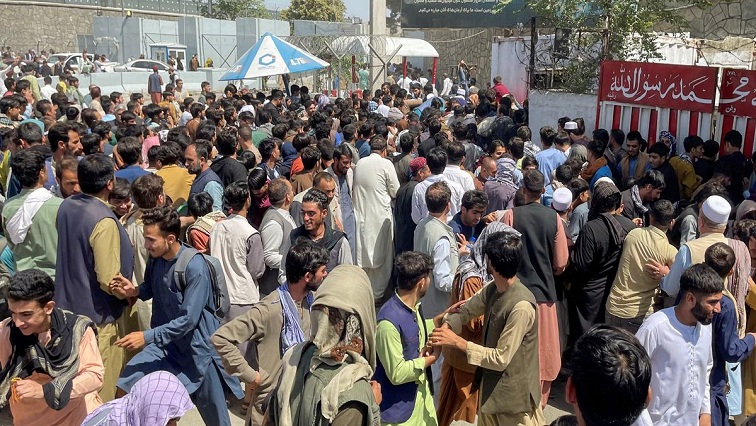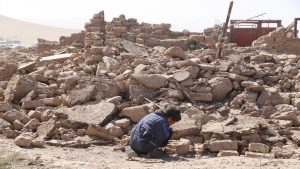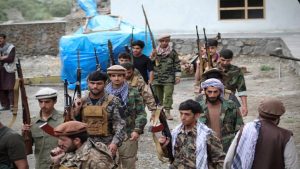Images of scores of desperate Afghan men, women and children – some clinging to a slowly moving US plane in a bid to sneak in, painted a horrific picture of America’s gross foreign policy failure.
Twenty years after the US stormed Afghanistan and toppled a Taliban government, the world watched in utter disbelief as the landlocked country at the crossroads of Central and South Asia drifted back to square one.
Two decades later and with thousands of fatalities from all sides of the battlefield, the US has reached a point where the agonising sight of its service personnel returning home in body bags need to come to an end.
During the 20 years of running Afghanistan like their own backyard, at a cost of a whopping $3.7 trillion (More than R50 trillion), the US has literally replaced a Taliban regime with another Taliban regime.
Under fire 46th US president Joe Bidden, whose approval rating has plummeted to its lowest since replacing Donald Trump, told the American public in a globalised address to the nation: “Our mission in Afghanistan was never supposed to have been nation-building. It was never supposed to be creating a unified, centralised democracy.” Wow!
This is in contrast to a clarion call made by former US President George W Bush, the mastermind behind the onslaught on Afghanistan.
On April 17, 2002 – following an effortless toppling of the Taliban regime and replacing them with a bunch of yes-men, President Bush called for a Marshall Plan for Afghanistan to counter the ubiquitous impoverishment of the Afghan people.
In a clear appeal to the international community to support a US-led nation-building effort in Afghanistan, President Bush was quoted during an address at the Virginia Military Institute as saying: “We know that true peace will only be achieved when we give the Afghan people the means to achieve their own aspirations. Peace will be achieved by helping Afghanistan develop its own stable government. Peace will be achieved by helping Afghanistan train and develop its own national army. And peace will be achieved through an education system for boys and girls which works.” Now, if this is not a call for nation-building, what is?
President Biden told the world this week that the US’s only national interest in Afghanistan was to prevent a terrorist attack emanating from the country and also to hunt down Osama Bin Laden, who was gunned down in neighbouring Pakistan during the Obama years.
Said President Biden: “We went to Afghanistan almost 20 years ago with clear goals: get those who attacked us on September 11, 2001, and make sure al-Qaida could not use Afghanistan as a base from which to attack us again. We did that. We severely degraded al-Qaida in Afghanistan. We never gave up the hunt for Osama bin Laden and we got him.”
America’s chaotic withdrawal from Afghanistan has raised more questions than answers. It is a reflection of a cantankerous foreign policy that lacks morality.
As the Western powers swiftly followed the US in flight out of Kabul international airport, the US was leaving behind a trail of anarchy in the streets of the capital as well as forlorn army and police barracks, where scores of US-trained Afghan forces fled the advancing warriors of the Taliban without putting up a fight.
Armoured vehicles, machine guns, military equipment were all abandoned during the hasty cut-and-run by the US forces.
NATO, including the UK, was unsurprisingly in tow as the Americans were fleeing Afghanistan under the watchful eye of the triumphant Taliban regime.
An agreement between the US and the Taliban is in place to allow for a smooth evacuation process of all US personnel and other Westerners, particularly staff of various EU-aligned embassies and Afghans who are known to have been on the payroll of the foreign forces – from spies to interpreters who are now understandably panic-stricken for fear of reprisals.
Of the few embassies that continue to operate in Kabul were those of China and Russia, the likely key players in the reconstruction and development of a new Afghanistan.
Their embassies were being protected by armed Taliban fighters.
The whole of Afghanistan is currently under the control of the Taliban, with the exception of Kabul international airport which has been turned into temporary HQ of frantic US and Western activities.
But Afghans who are trapped inland appear to be in real trouble. US Defence Secretary Lloyd Austin says the US military lacks the capacity to go out and collect large numbers of citizens and get them to the airport.
They are incapable of extending US security forces beyond the perimeter of the Kabul airport in order to get more civilians safely evacuated out of Afghanistan.
The remarkable capitulation of the Afghan security forces visibly irked President Biden, who bemoaned the Afghan security forces’ “lack of will to fight” and found that rather astonishing. In other words, it had to be the US forces fighting the Taliban on their behalf, a situation quite unacceptable by the Biden administration.
By the time the Taliban fighters arrived in the capital Kabul, Afghan President Ashraf Ghani had fled the country, reportedly with bags of money, en route to exile for a plush lifestyle.
Days later, he emerged in a Facebook post in the United Arab Emirates, a staunch ally of the US.
This gave rise to suspicion that Washington aided Ghani’s flight out of the country he had ruled through a manual of the Americans, which included many chapters that undermined the Islamic way of life.
In the final analysis, according to the US authorities, the Afghans need to learn to resolve their own problems without external interference. In my book, the observation is 20 years late and costly.
The inherent problem with Western democracies is that their powerful regimes are hell-bent on imposing their ways of life on everybody around the world.
They don’t give a damn about people’s cultures and traditions, including languages in many instances. In fact, anything that is distinctly not Western is regarded as plain barbaric.
This week, when four pro-Western Afghan women held placards in Kabul chanting feminist slogans several US news networks ludicrously described the event as a “rally”, unaware that the visuals exposed their subjectivity.
The ulterior motive seemed to mask a narrative that paints the Taliban as backward.
In my view, successful change always has to come from within – from societies themselves without sly coercion as we have seen through the dodgy foreign policy of the US that seeks to impose its will on everybody.
With every sinew in their body, the Taliban are Afghanistan and Afghanistan is the Taliban.
The people of Afghanistan have every right to accept or reject their new rulers – without any external interference or influence.
Otherwise, that is a recipe for disaster, as the Americans have learnt 20 years later just as they discovered in the fall of Saigon on April 30, 1975, marking the end of the infamous Vietnam War that started in 1955.
Exactly four days after coming to power the Taliban has announced the creation of the Islamic Emirates of Afghanistan – a new country, accompanied by a swift alteration to the national flag, some 102 years after Britain relinquished its rule over the country.
Hopefully, the US and the rest of the so-called Western civilisation would have learnt valuable lessons that nations are all different and sovereign, and that under international law unilateralism as often practised by Washington is downright illegal, and economically preposterous.






